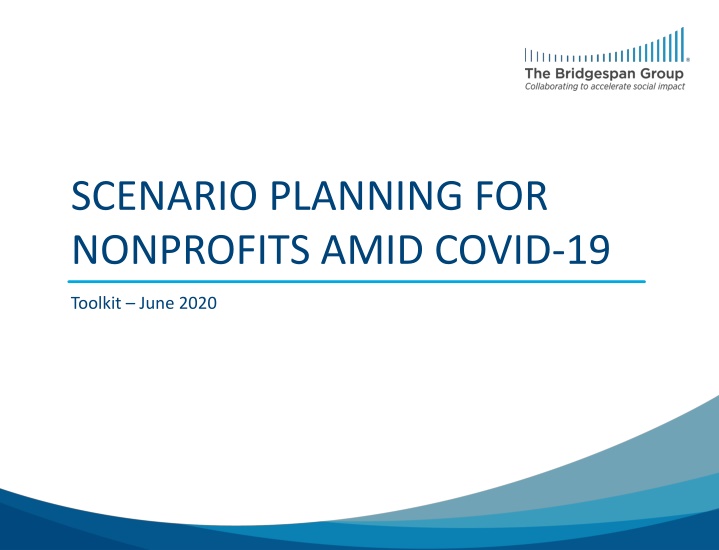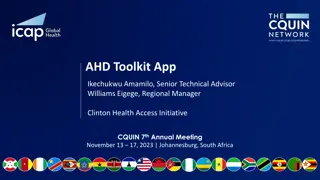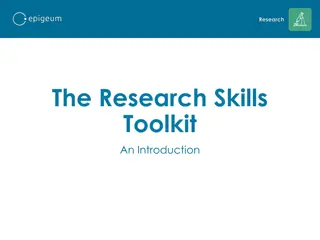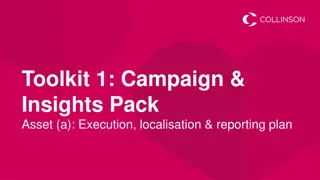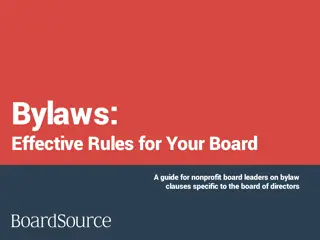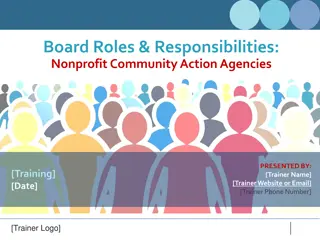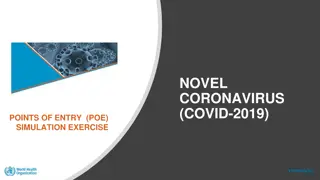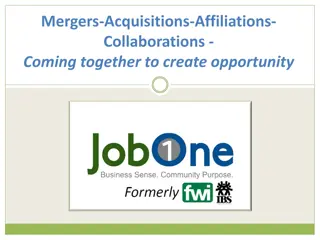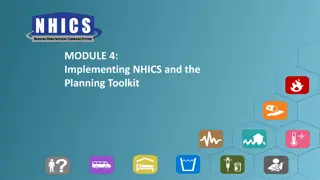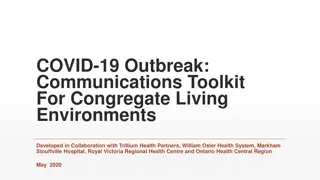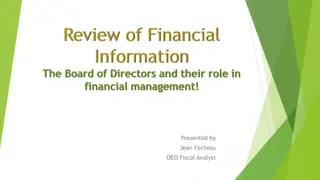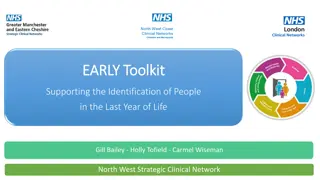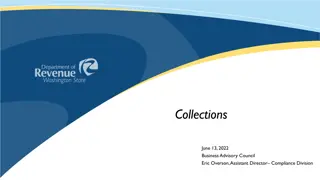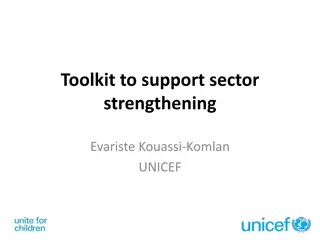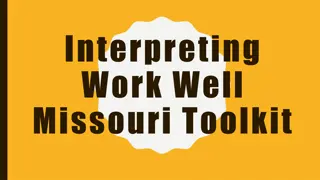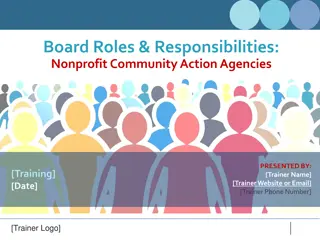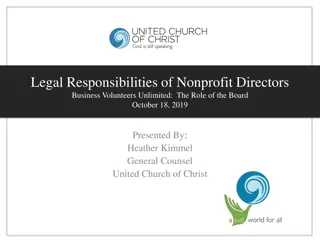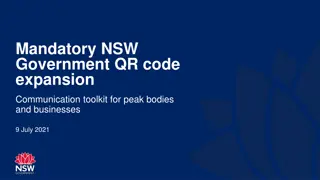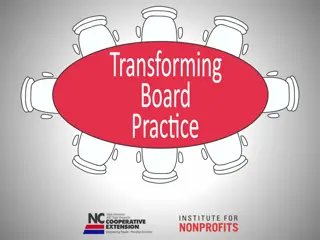Nonprofit Scenario Planning Amid COVID-19 Toolkit
The toolkit provides a four-step scenario planning process to help nonprofit leaders navigate uncertainty caused by COVID-19. It emphasizes identifying key drivers, developing scenarios, creating action plans, and determining trigger points for effective decision-making. This approach focuses on continuity, recovery, and informing long-term strategy amidst the pandemic's disruptions.
Download Presentation

Please find below an Image/Link to download the presentation.
The content on the website is provided AS IS for your information and personal use only. It may not be sold, licensed, or shared on other websites without obtaining consent from the author.If you encounter any issues during the download, it is possible that the publisher has removed the file from their server.
You are allowed to download the files provided on this website for personal or commercial use, subject to the condition that they are used lawfully. All files are the property of their respective owners.
The content on the website is provided AS IS for your information and personal use only. It may not be sold, licensed, or shared on other websites without obtaining consent from the author.
E N D
Presentation Transcript
SCENARIO PLANNING FOR NONPROFITS AMID COVID-19 Toolkit June 2020
Overview The scenario planning process helps organization leaders navigate uncertainty while providing structure around making key strategic decisions. In the context of COVID-19, scenario planning has become more important than ever. The pandemic has introduced an unprecedented level of uncertainty and disruption among organizations around the world its impact is being felt across every sector and geography. As such, it is critical for organization leaders to engage in an iterative scenario planning process that accounts for factors outside of your control (e.g., shelter-in-place restrictions and the pace of economic recovery) and actions and options within your control (e.g., operational shifts and cost reductions). This toolkit shares a four-step scenario planning process anchored in preserving your organization s ability to pursue its mission. Specifically, it will help you and your leadership team identify key drivers (the ones most important to your organization s economics and impact, and facing the highest levels of risk), develop a range of best-, moderate-, and worst-case scenarios over the next ~6-12 months, create related action plans for each scenario, and determine triggers that tell you when to put plans into action. This approach focuses primarily on continuity and recovery, though it will likely inform important questions and decisions surrounding your organization s long-term strategy. For further detail, please see the article Making Sense of Uncertainty: Nonprofit Scenario Planning in the COVID-19 Pandemic. 2
Scenario Planning Process Identify key drivers at risk 1 Identify the drivers (i.e., major elements) of your organization s economics and impact Note which drivers are at both a high level of importance and a high level of risk you will use these in step 2 to develop scenarios 1 Develop and model scenarios 2 Construct best-, moderate-, and worst-case scenarios anchored in the key drivers highlighted in Step 1 and relevant external factors outside of your control Continuous Iteration as circumstances change, new information is available 2 Translate scenarios to reflect their impact on your ~6-12 month revenue forecast 4 Create a portfolio of actions 3 Develop a set of actions that would allow you to effectively manage against each scenario Quantify the financial impact of these actions to understand total estimated savings achieved or costs incurred 3 Determine key trigger points 4 Determine concrete and measurable trigger points that will help prompt your organization to act at the right time Monitor them regularly to help your leadership team make and execute decisions quickly as circumstances evolve 3
Guiding Principles Before you begin the scenario planning process, consider aligning on a set of guiding principles values based criteria with your leadership team to inform decision making in the face of uncertainty Guiding principles are critical in times of crisis Explicit principles to guide decision making can help in several ways: Align organization s leadership to make tough decisions in the face of uncertainty Ensure equity-related considerations receive proper attention Allow leadership to communicate rationale behind key decisions to stakeholders There is no checklist of off-the-shelf guiding principles to use in a crisis; each nonprofit must chart their own course and must be tailored for each organization In general, principles should reflect an organization s mission, values, unique circumstances and an equity lens Examples include: We will find ways to safely and effectively continue our most critical programs We will prioritize the well-being of our people through the crisis We will avoid programmatic or operational shifts that disproportionately harm people of color We will preserve the long-term financial health of our org by maintaining X months of reserves Related article: A Compass for the Crisis: Nonprofit Decision Making in the COVID-19 Pandemic 4
Step 1: Identify key drivers at risk Nonprofit leaders face an unprecedented number of uncertainties and risks amid COVID-19 that span all aspects of their organizations only a subset of these matter most and it is critical to prioritize among them in scenario planning. To complete this worksheet, first identify the drivers (i.e., major elements) of your organization s economics and impact across three categories: programs,* operations, and funding. Next, assess the level of importance of each driver to your organization and the level of risk each faces. In evaluating levels of risk, consider three questions: (1) What is the nature of the risk? (2) What is the likelihood of the risk? (3) What is the level of impact of the risk? After completing the chart, note which drivers are at both a high level of importance (to organization economics and/or impact) and a high level of risk you will use these in the next worksheet to develop scenarios. Level of IMPORTANCE* Level of RISK Identify key drivers of organization economics and impact List drivers of programmatic impact Low / Med / High Low / Med / High E.g., student enrollment, patient volume, etc. Programs Low / Med / High Low / Med / High Low / Med / High Low / Med / High Low / Med / High Low / Med / High List drivers of organization operations Operations Low / Med / High Low / Med / High E.g., facilities, operational staff capacity, etc. Low / Med / High Low / Med / High Low / Med / High Low / Med / High List drivers of organization revenue Low / Med / High Low / Med / High E.g., fee-for-service revenue, government grants, etc. Funding Low / Med / High Low / Med / High Low / Med / High Low / Med / High Low / Med / High Low / Med / High *Level of importance in this context refers to the driver s contribution to your organization s economics (e.g., percentage of revenue or expenses) and/or your mission (e.g., role in achieving target outcomes) 5
Step 2: Develop and model scenarios Consolidate the best data available to construct best-, moderate-, and worst-case scenarios that reflect the full spectrum of possible outcomes for your organization. First, elevate which external factors (factors outside of your control) will directly impact your organization these may include shelter-in-place restrictions, unemployment rates, the pace of economic recovery, etc. Next, estimate the potential impact that these external factors could have on the key drivers of your organization s impact and economics prioritized in Step 1. Once you have developed these scenarios, translate them into their related impact on your organization s revenue forecast over a short- to medium-term time horizon relevant for your organization (e.g., ~6-12 months). External factors that directly impact our organization BEST CASE MODERATE CASE WORST CASE E.g., shelter-in-place restrictions June 30th release of restrictions Aug 30th release of restrictions Oct 30th release of restrictions Prioritized key internal drivers from STEP 1 BEST CASE MODERATE CASE WORST CASE E.g., program volume (patients served) Slight decrease (e.g., 10-15%) Moderate decrease (e.g., 15-30%) Major decrease (e.g., 30-45%) Programs E.g., frontline staff capacity Slight decrease (e.g., 10-15%) Moderate decrease (e.g., 15-30%) Major decrease (e.g., 30-45%) Operations E.g., fee-for-service revenue Slight decrease (e.g., 10-15%) Moderate decrease (e.g., 15-30%) Major decrease (e.g., 30-45%) Funding Projected impact on our organization s revenue forecast $ $ $ 6
Step 3: Create a portfolio of actions Develop a set of potential actions that would enable your organization to successfully manage against each scenario, preserving both your financial viability and your ability to deliver impact. Actions typically fall into one of three categories: (1) appropriate for any scenario, (2) smaller-scale and more flexible, (3) larger and more permanent. As you identify potential actions, weigh the pros and cons of each and ensure they fall in line with any guiding decision principles agreed upon by your leadership team. Most of these actions will likely have some economic cost or benefit. Quantify the potential costs incurred and/or savings achieved for each action (over the time horizon the action would be implemented), and then calculate the total estimated costs incurred or savings achieved by each set of actions for your best-, moderate-, and worst-case scenarios. ______________ Case Scenario (create one action plan for each scenario; appropriate for any scenario will be the same in each) Estimated cost (+ or -) Category Definition Actions Actions that will positively affect your organization s ability to deliver impact and financial position under any future scenario $ Appropriate for any scenario E.g., Eliminate discretionary budget expenses travel, office supplies, etc. $ $ $ Smaller-scale, flexible investments or cost reduction measures that can be executed quickly (and reversed) if various scenarios come to fruition $ Smaller-scale and more flexible E.g., Reduce executive-level salaries by XX% $ $ $ Large-scale investments or cost reduction measures that may be more permanent in nature $ Larger and more permanent E.g., Layoff nonessential staff $ $ $ $ Total estimated costs incurred or savings achieved 7
Step 4: Determine key trigger points Many of the potential actions outlined for each scenario in Step 3 (with the exception of appropriate for any scenario ) will only make sense under certain circumstances. Determine concrete and measurable trigger points for each action in the smaller-scale and more flexible or larger and more permanent categories. Some actions you outline may be relevant across different scenarios. Likewise, you many find that one trigger (e.g., extension of shelter-in-place restrictions) is the best gauge for multiple actions. This worksheet will help consolidate your list of potential actions and related trigger points, serving as a dashboard for your leadership team to support continuous monitoring and rapid decision making as circumstances evolve. Scenarios Key trigger points (to prompt action at the right time) Best case Moderate case Worst case Actions E.g., Reduce executive-level salaries XX% E.g., Total projected revenue falls XX% below budget 8
